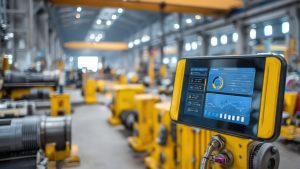Deep learning is transforming industries. It’s pushing boundaries in manufacturing, healthcare, and finance. But there’s another field ripe for a deep learning revolution: maintenance. Imagine predicting equipment failures before they even happen using algorithms and models capable of identifying patterns in data points and predicting future outcomes. Leveraging deep learning in maintenance is a total game changer for optimizing efficiency.
Table Of Contents:
- Understanding Deep Learning in Maintenance
- Predictive Maintenance: The Power of Deep Learning
- Advanced Analytics for Maintenance Optimization
- Real-World Applications of Deep Learning in Maintenance
- Future Trends and Innovations in Deep Learning for Maintenance
- Conclusion
Understanding Deep Learning in Maintenance
Imagine a team of virtual mechanics poring over sensor readings, uncovering hidden patterns that humans might miss. That’s deep studying, in a nutshell. At its core, deep mastering uses artificial intelligence (AI) and machine-gaining knowledge (ML) algorithms to sift through sizeable datasets, studying from enjoy and recognizing subtle correlations to create an information-driven technique for renovation.
Traditional maintenance strategies regularly rely upon scheduled inspections and habitual exams, which could cause pointless downtime and accelerated costs. However, with deep knowledge, we’re entering a new age of prediction and proactiveness, using large records analytics to investigate time-series information gathered from various resources. This shift allows for a more green, proactive approach to preservation, lowering downtime and charges while enhancing standard gadget effectiveness.
Predictive Maintenance: The Power of Deep Learning
Predictive renovation is all about preventing troubles before they start. Deep learning algorithms analyze information, historical preservation logs, and environmental factors to predict future disasters. This offers agencies a much clearer image of their system’s fitness. They can anticipate failures and agenda upkeep best when it is definitely desired.
Consider how greener companies might be if they leverage deep maintenance knowledge to enhance upkeep practices. Instead of high-priced downtime and reactive upkeep, imagine an international where preservation takes place seamlessly. It’s already a fact in many industries.
For instance, Grand View Research predicts the global predictive maintenance market will attain an amazing $64.25 billion by 2025. Those numbers display the transformative strength of this technology. This is due, in no small part, to deep gaining knowledge, allowing greater green renovation techniques through leveraging historical information.
Advanced Analytics for Maintenance Optimization
In digital transformation technology, facts analysis stands at the vanguard of optimizing preservation operations. The introduction of deep-gaining knowledge has taken this process to remarkable heights. By leveraging advanced algorithms, deep mastering enables a complete understanding of working situations and capacity issues that may arise, supplying a proactive method to upkeep.
More Accurate Predictions
Imagine having the capacity to foresee gadget disasters earlier than they arise. Deep mastering models excel at reading sizable amounts of historical and real-time data, figuring out styles and anomalies that human eyes may leave out. This heightened accuracy means that agencies can expect device screw-ups with greater precision, minimizing unexpected downtime and lowering the prices related to emergency repairs. Instead of reacting to problems, organizations can preemptively deal with capacity issues, ensuring smoother operations and prolonging the lifespan of their equipment.
Optimized Maintenance Schedules
Gone are the days of inflexible, calendar-primarily-based renovation schedules. With deep knowledge, preservation sports can be dynamically scheduled based on real-time records. This means preservation is completed exactly while it’s wanted in place of following arbitrary timelines. Sensors on devices constantly reveal overall performance and ship data to the deep learning fashions, which then decide the most appropriate preservation times. This ensures that machinery is serviced at the right periods, improving productivity and performance while preventing below-preservation and over-protection.
Data-Driven Insights
The fee of records in present-day business cannot be overstated, and deep learning amplifies this price by extracting actionable insights from complex datasets. Analyzing records from diverse resources—together with sensor readings, maintenance logs, and environmental situations—deeply gaining knowledge of algorithms offers businesses a holistic view of their operations. These insights inform strategic decision-making, assisting organizations to optimize their maintenance strategies, allocate assets more efficiently, and discover opportunities for improvement. The capability to make statistics-pushed choices empowers groups to beautify ordinary operational performance and preserve an aggressive facet.
Deep knowledge of advanced analytics competencies no longer enhances the accuracy of predictions and optimizes preservation schedules but also unencumbers a treasure trove of facts-driven insights. This transformation allows businesses to transition from reactive to proactive preservation techniques, resulting in significant price savings, expanded gadget reliability, and advanced overall operational performance.
Real-World Applications of Deep Learning in Maintenance
Industries worldwide are seeing amazing achievements leveraging deep learning to preserve their assets. Here are some actual-world examples to give you a concept of what is taking place. Take manufacturing, for example, which uses deep knowledge to predict system screw-ups by studying sensor readings.
Another is transportation, where deep learning optimizes vehicle maintenance schedules. Healthcare uses deep learning for medical equipment upkeep, reducing downtime and ensuring reliability. The insights gained from the data have a symbiotic relationship with the maintenance processes.
| Industry | Application | Benefits |
|---|---|---|
| Manufacturing | Predicting machine failures | Reduced downtime, improved production efficiency |
| Transportation | Optimizing vehicle maintenance schedules | Increased vehicle uptime, reduced maintenance costs |
| Healthcare | Medical equipment upkeep | Improved patient safety, reduced equipment downtime |
Future Trends and Innovations in Deep Learning for Maintenance
The transformative energy of leveraging deep learning in maintenance is only beginning to be realized. Artificial intelligence, mainly machine-gaining knowledge of fashions, is revolutionizing how we approach protection, allowing a shift from reactive to proactive strategies. Here are a number of the destiny traits to observe:
Edge Computing
Edge computing is about revolutionizing deep learning knowledge by bringing processing energy to the statistics supply. This approach allows quicker evaluation and decreases latency, allowing for real-time insights and greater on-the-spot movements. Imagine instantly making maintenance selections right where the facts are generated—on the manufacturing unit floor or in the area. This immediacy enhances the effectiveness of predictive upkeep and permits greater specific interventions, minimizing downtime and maximizing productivity.
Integration with Blockchain
Integrating deep knowledge with cutting-edge technology like blockchain will beautify records security extensively. Blockchain’s decentralized ledger gadget makes it much tougher for hackers to compromise facts integrity. This accelerated protection is critical for maintenance operations that depend upon correct and trustworthy information. Additionally, the aggregate of deep learning and blockchain will pressure further research and improvement into innovative solutions, ensuring that renovation strategies aren’t only efficient and noticeably steady. This symbiotic dating between those technologies promises to push the bounds of what’s viable in predictive preservation.
Hyperautomation
Hyperautomation, the subsequent step past conventional automation, entails using superior technology like AI, device getting-to-know, and robot method automation (RPA) to automate complicated business approaches. In the protection context, hyper-automation will enable systems to automatically locate problems, expect failures, and even order replacement parts without human intervention. This degree of automation will appreciably lessen preservation prices and improve operational efficiency by ensuring protection activities are constantly well-timed and effective.
Enhanced Predictive Analytics
The future will greatly rely on predictive analytics powered by increasingly sophisticated deep learning algorithms. These algorithms will anticipate device screwups and provide deeper insights into the basic reasons for those disasters. This understanding will enable companies to cope with underlying troubles, prevent destiny failures, and lengthen the life of their devices. Enhanced predictive analytics will transform upkeep from a reactive project to a strategic, preventative operation.
IoT Integration
The Internet of Things (IoT) will play a significant function in the evolution of deep learning for renovation. With the proliferation of IoT gadgets and sensors, the quantity of facts available for analysis will boom exponentially. Deep-mastering fashions might be capable of processing these statistics to offer real-time insights into equipment fitness and overall performance. IoT integration will enable a more connected and responsive renovation device wherein records from various assets are continuously analyzed to optimize preservation schedules and tactics.
Advanced Human-Machine Collaboration
Maintenance can even see more desirable collaboration between people and machines in the future. Advanced AI structures will help upkeep employees by offering actual-time diagnostics and guidelines, augmenting human abilities. This collaboration will make renovation techniques extra green and less error-susceptible, as AI systems can analyze sizeable quantities of information and discover styles that people might omit. By working together, human beings and AI can gain better ranges of accuracy and performance in protection operations.
Conclusion
The future of protection is right here, and it is powered by deep knowledge, permitting a proactive and predictive technique for asset control. Companies using deep studying technology, such as predictive models and neural networks, can drastically boost efficiency and reduce the need for reactive upkeep, leading to large-value financial savings.
By leveraging advanced predictive models, agencies can, as it should be, forecast gadget screwups earlier than they occur. Neural networks, a key element of deep learning, analyze vast quantities of statistics to recognize patterns and predict consequences, enhancing maintenance strategies and decreasing surprising downtime.
Moreover, mixing RUL prediction (Remaining Useful Life) in preservation tactics lets organizations decide the exact time before a chunk of the device needs preservation. This precision ensures that protection is done best when necessary, optimizing resources and extending the lifespan of gadgets.
As industries adopt these practices and technology, leveraging deep learning in maintenance will become known in asset management, supplying massive advantages to operational uptime. This approach now reduces downtime and optimizes assets for any enterprise trying to stay ahead in today’s fast-paced surroundings. Deeply gaining knowledge will enhance data series and circumstance tracking, empowering groups to make knowledgeable upkeep decisions with comprehensive knowledge of their belongings.
In summary, the adoption of deep mastering in preservation isn’t just about keeping up with technological developments; it is about leading the way, making smarter choices, and maintaining a competitive edge within the digital age. By using neural networks and predictive models, corporations can transform their renovation techniques, ensuring they remain agile, aggressive, and prepared for whatever destiny holds.



